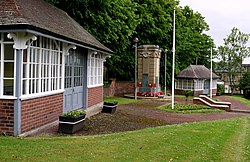Birtley, County Durham
| Birtley | |
| County Durham | |
|---|---|
 War Memorial Garden | |
| Location | |
| Grid reference: | NZ271563 |
| Location: | 54°54’-0"N, 1°34’37"W |
| Data | |
| Population: | 8,367 (2011) |
| Post town: | Chester-le-Street |
| Postcode: | DH3 |
| Dialling code: | 0191 |
| Local Government | |
| Council: | Gateshead |
| Parliamentary constituency: |
Blaydon |
Birtley is a town in County Durham, situated to the south of Gateshead and physically linked to Chester-le-Street. It forms a township of the ancient parish of Chester-le-Street. A corresponding civil parish was abolished in April 2006, after a local referendum.[1]
Industry
Birtley is the home of the Royal Ordnance Factory, ROF Birtley and the Komatsu Heavy Engineering Company, which operates from the previous premises of Birtley Iron Works (opened in 1827, which became premises of the Caterpillar Company in the mid-20th century).
The Royal Ordnance Factory was a major target of the German Luftwaffe in World War Two. Thanks to its reputation as a 'misty valley', Birtley and the factory survived many hits. The phrase 'misty valley' was coined by Tommy Lawton, a worker at the ROF in the 1970s.
The ROF factory, operated by BAE, was replaced in late 2011 by a new purpose-built 350,000-sq. ft factory in nearby Washington and replaced the old Dunlop Tyre factory. The entire Birtley workforce moved to this site.
The Japanese heavy engineering firm Komatsu is now the town's main employer, with almost 400 staff.[2]
Mining was a very important industry in Birtley. Birtley Iron Company had 10 pits in the area surrounding Birtley, employing 3,736 below ground and 960 people above ground.[3] There was also a lot of coal mining in the area, with the earliest recorded instance was in 1351. This continued until the 1960s, when the trade declined.[4]
Elisabethville
Elisabethville was a sovereign Belgian area of Birtley housing Belgian refugees, who worked at the Royal Ordnance Factory during World War One.[5] It was a community of 6,000 residents who were accommodated in a mixture of hostels and cottages.[6] When the war ended and the inhabitants were largely repatriated, it was occupied by people of British and other nationalities[5] before its demolition and replacement with more permanent housing. Its history is told in the book The Birtley Belgians.
Angel of the North

Antony Gormley's famous Angel of the North, completed in February 1998, is on high ground at the site of the baths of the old 'Betty Ann Pit' to the north of Birtley. Overlooking the area, it is seen by around 90,000 people per day by people on the A1 and on the East Coast Main Line.[7] In summer 2011, a landscaped car park, near the Angel, was laid to accommodate the increased number of cars and coaches visiting the site.
Religion
There are altogether three mainstream churches in Birtley, which also has a large cemetery with a chapel and crematorium:
- St Joseph's (Roman Catholic)[8] Built in 1843 after the Roman Catholic Relief Act 1791 and designed by John Dobson in early Gothic style.
- St John the Evangelist (Church of England)[9]
- Birtley Methodist Church[10]
Transport links

The main road through Birtley is the non-primary A167, which runs from Topcliffe in the North Riding of Yorkshire through to the north of Newcastle upon Tyne and is the same road which runs across the Tyne Bridge. This was an original route for the Great North Road and the A1 until a bypass was built (which was upgraded to motorway standard in the 1960s).
Main-line trains used to stop at the town's long dismantled station. Birtley railway station was closed on 5 December 1955. The Station Hotel was closed in 1971, having been opened in 1868 or earlier.
References
- ↑ Referendum to abolish Civil Parish
- ↑ Komatsu Manufacturing & Assembly Plant Birtley
- ↑ http://www.dmm.org.uk/company/b025.htm
- ↑ http://www.asaplive.com/Local/Histories.cfm?ccs=529&cs=1979
- ↑ 5.0 5.1 BBC – World War One: How 250,000 Belgium refugees didn't leave a trace
- ↑ http://www.thejournal.co.uk/news/north-east-news/first-world-war-commemorations-begin-7597456
- ↑ http://www.gateshead.gov.uk/Leisure%20and%20Culture/attractions/Angel/Background/Background2.aspx
- ↑ [1]
- ↑ St. John the Evangelist Church
- ↑ Birtley Methodist Church.